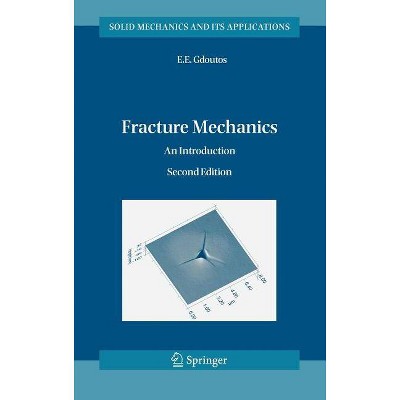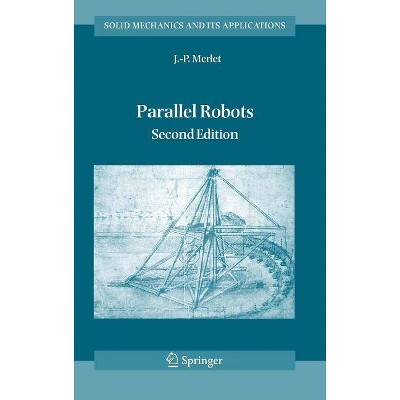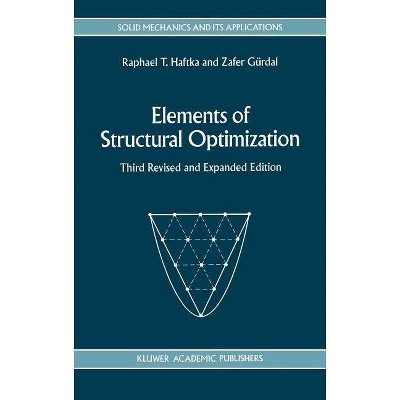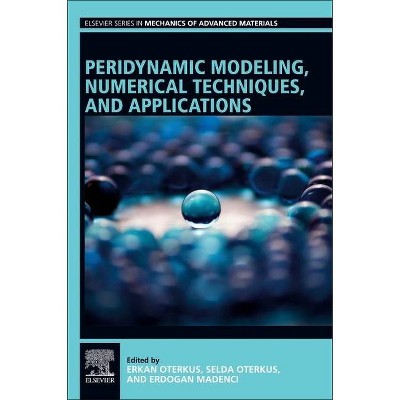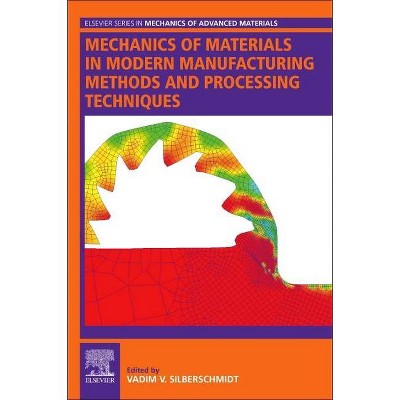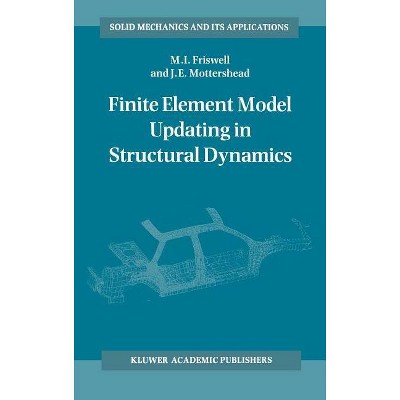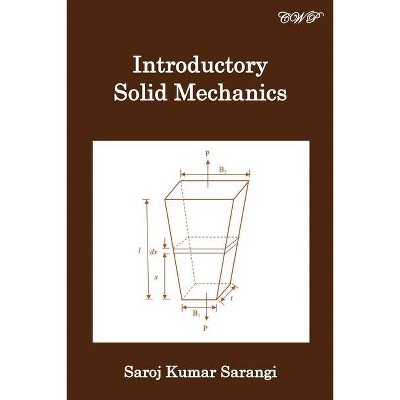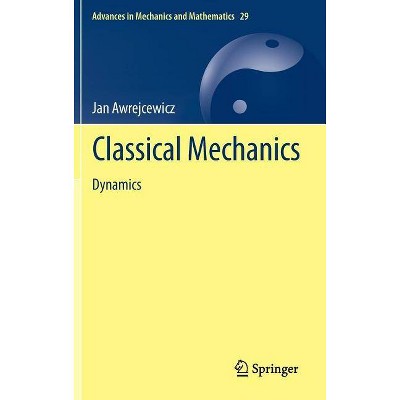Intermediate Mechanics of Materials - (Solid Mechanics and Its Applications) 2nd Edition by J R Barber (Hardcover)

Similar Products
Products of same category from the store
AllProduct info
<p/><br></br><p><b> About the Book </b></p></br></br><p>This updated second edition of the second-level course book covers the essential topics in strength and mechanics of materials, with an emphasis on techniques that are useful for mechanical design. It bridges the gap between theory and real-world applications.</p><p/><br></br><p><b> Book Synopsis </b></p></br></br><p><b>Introduction.- </b>1.1 The Engineering design process;1.2 Design optimization;1.2.1 Predicting the behaviour of the component.- 1.2.2 Approximate solutions.- 1.3 Relative magnitude of different effects.- 1.4 Formulating and solving problems.- 1.4.1 Use of procedures.- 1.4.2 Inverse problems.- 1.4.3 Physical uniqueness and existence arguments.- 1.5 Review of elementary mechanics of materials.- 1.5.1 Definition of stress components.- 1.5.2 Transformation of stress components.- 1.5.3 Displacement and strain.- 1.5.4 Hooke's law.- 1.5.5 Bending of beams.- 1.5.6 Torsion of circular bars.- 1.6 Summary.- Problems.- <b>2 Material Behaviour and Failure.- </b>2.1 Transformation of stresses.- 2.1.1 Review of two-dimensional results.- 2.1.2 Principal stresses in three dimensions.- 2.2 Failure theories for isotropic materials.- 2.2.1 The failure surface.- 2.2.2 The shape of the failure envelope.- 2.2.3 Ductile failure (yielding).- 2.2.4 Brittle failure.- 2.3 Cyclic loading and fatigue.- 2.3.1 Experimental data.- 2.3.2 Statistics and the size effect.- 2.3.3 Factors influencing the design stress.- 2.3.4 Effect of combined stresses.- 2.3.5 Effect of a superposed mean stress.- 2.3.6 Summary of the design process.- 2.4 Summary.- Problems.- <b>3 Energy Methods.- </b>3.1 Work done on loading and unloading.- 3.2 Strain energy.- 3.3 Load-displacement relations.- 3.3.1 Beams with continuously varying bending moments.- 3.3.2 Axial loading and torsion.- 3.3.3 Combined loading.- 3.3.4 More general expressions for strain energy.- 3.3.5 Strain energy associated with shear forces in beams.- 3.4 Potential energy.- 3.5 The principle of stationary potential energy.- 3.5.1 Potential energy due to an external force.- 3.5.2 Problems with several degrees of freedom.- 3.5.3 Non-linear problems.- 3.6 The Rayleigh-Ritz method.- 3.6.1 Improving the accuracy.- 3.6.2 Improving the back of the envelope approximation.- 3.7 Castigliano's first theorem.- 3.8 Linear elastic systems.- 3.8.1 Strain energy.- 3.8.2 Bounds on the coefficients.- 3.8.3 Use of the reciprocal theorem.- 3.9 The stiffness matrix.- 3.9.1 Structures consisting of beams.- 3.9.2 Assembly of the stiffness matrix.- 3.10 Castigliano's second theorem.- 3.10.1 Use of the theorem.- 3.10.2 Dummy loads.- 3.10.3 Unit load method.- 3.10.4 Formal procedure for using Castigliano's second theorem.- 3.10.5 Statically indeterminate problems.- 3.10.6 Three-dimensional problems.- 3.11 Summary.- Problems.- <b>4 Unsymmetrical Bending.- </b>4.1 Stress distribution in bending.- 4.1.1 Bending about the <i>x</i>-axis only.- 4.1.2 Bending about the <i>y</i>-axis only.- 4.1.3 Generalized bending.- 4.1.4 Force resultants.- 4.1.5 Uncoupled problems.- 4.1.6 Coupled problems.- 4.2 Displacements of the beam.- 4.3 Second moments of area.- 4.3.1 Finding the centroid.- 4.3.2 The parallel axis theorem.- 4.3.3 Thin-walled sections.- 4.4 Further properties of second moments.- 4.4.1 Coordinate transformation.- 4.4.2 Mohr's circle of second moments.- 4.4.3 Solution of unsymmetrical bending problems in principal coordinates.- 4.4.4 Design estimates for the behaviour of unsymmetrical sections.- 4.4.5 Errors due to misalignment.- 4.5 Summary.- Problems.- <b>5 Non-linear and Elastic-Plastic Bending.- </b>5.1 Kinematics of bending.- 5.2 Elastic-plastic constitutive behaviour.- 5.2.1 Unloading and reloading.- 5.2.2 Yield during reversed loading.- 5.2.3 Elastic-perfectly plastic material.- 5.3 Stress fields in non-linear and inelastic bending.- 5.3.1 Force and moment resultants.- 5.4 Pure bending about an axis of symmetry.- 5.4.1 Symmetric problems for elastic-perfectly plastic materials.- 5.4.2 Fully plastic moment and shape factor.- 5.5 Bending of a symmetric section about an orthogonal axis.- 5.5.1 The fully plastic case.- 5.5.2 Non-zero axial force.- 5.5.3 The partially plastic solution.- 5.6 Unsymmetrical plastic bending.- 5.7 Unloading, springback and residual stress.- 5.7.1 Springback and residual curvature.- 5.7.2 Reloading and s<p/><br></br><p><b> From the Back Cover </b></p></br></br><p>This book covers the essential topics for a second-level course in strength of materials or mechanics of materials, with an emphasis on techniques that are useful for mechanical design. Design typically involves an initial conceptual stage during which many options are considered. At this stage, quick approximate analytical methods are crucial in determining which of the initial proposals are feasible. The ideal would be to get within 30% with a few lines of calculation. The designer also needs to develop experience as to the kinds of features in the geometry or the loading that are most likely to lead to critical conditions. </p><p> </p><p>With this in mind, the author tries wherever possible to give a physical and even an intuitive interpretation to the problems under investigation. For example, students are encouraged to estimate the location of weak and strong bending axes and the resulting neutral axis of bending before performing calculations, and the author discusses ways of getting good accuracy with a simple one degree of freedom Rayleigh-Ritz approximation. Students are also encouraged to develop a feeling for structural deformation by performing simple experiments in their outside environment, such as estimating the radius to which an initially straight bar can be bent without producing permanent deformation, or convincing themselves of the dramatic difference between torsional and bending stiffness for a thin-walled open beam section by trying to bend and then twist a structural steel beam by hand-applied loads at one end. </p><p> </p><p>In choosing dimensions for mechanical components, designers will expect to be guided by criteria of minimum weight, which with elementary calculations, generally leads to a thin-walled structure as an optimal solution. This consideration motivates the emphasis on thin-walled structures, but also demands that students be introduced to the limits imposed by structural instability. Emphasis is also placed on the effect of manufacturing errors on such highly-designed structures - for example, the effect of load misalignment on a beam with a large ratio between principal stiffness and the large magnification of initial alignment or loading errors in a strut below, but not too far below the buckling load. </p><p>This is the second edition of a course in mechanics of materials. Additional material can be found on http: //extras.springer.com/ .</p><p/><br></br><p><b> Review Quotes </b></p></br></br><br><p>From the reviews of the second edition: </p><p>"Presented as a textbook for a second course in the general area of solid mechanics in the mechanical, civil, and aerospace engineering curricula. ... Some unique features are the inclusion of chapters on axisymmetric membrane and bending behavior of shells and approximate techniques in energy methods ... . Overall, an excellent presentation of selected topics in mechanics with numerous exercises (over 400) and 80-plus worked-out examples to illustrate concepts/applications. Summing Up: Highly recommended. Academic libraries, upper-division undergraduates, graduate students, faculty, and practicing engineers." (R. Kolar, Choice, Vol. 48 (11), August, 2011)</p><p>"This textbook covers a course in strength of materials, containing also analytical and numerical methods used in the industrial mechanical design. ... The book is completed by an appendix on finite element method, widely applied in structural mechanics. The work may be useful to civil and mechanical engineers." (Olivian Simionescu, Zentralblatt MATH, Vol. 1218, 2011)</p><br><p/><br></br><p><b> About the Author </b></p></br></br><p>J.R.BARBER </p><p>J.R.BARBER graduated in Mechanical Sciences from Cambridge University in 1963 and joined British Rail, who later sponsored his research at Cambridge between 1965 and 1968 on the subject of thermal effects in braking systems. In 1969 he became Lecturer and later Reader in Solid Mechanics at the University of Newcastle upon Tyne. In 1981 he moved to the University of Michigan, where he is presently Arthur F Thurnau Professor of Mechanical Engineering and Applied Mechanics. He is a Chartered Engineer in the U.K., Fellow of the Institution of Mechanical Engineers, and has engaged extensively in consulting work in the field of stress analysis for engineering design.</p> <p>He is author of two books ('Elasticity' and 'Intermediate Mechanics of Materials') and over 160 articles in the fields of Elasticity, Thermoelasticity, Contact Mechanics, Tribology, Heat Conduction and Elastodynamics. He is a recipient of the Drucker Medal of ASME and the Archie Higdon Distinguished Educator Award of ASEE. He has served as Associate Editor of the Journal of Applied Mechanics and Mathematical Problems in Engineering and is a member of the editorial boards of the International Journal of Mechanical Sciences, the Journal of Thermal Stresses, MilleChili Journal and Acta Tribologica. </p> <p>http: //www-personal.umich.edu/~jbarber/ </p>
Price History
Cheapest price in the interval: 109.99 on October 27, 2021
Most expensive price in the interval: 109.99 on December 20, 2021
Price Archive shows prices from various stores, lets you see history and find the cheapest. There is no actual sale on the website. For all support, inquiry and suggestion messagescommunication@pricearchive.us
